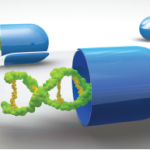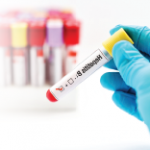 In 2021, the ACR—in concert with the Vasculitis Foundation (VF)—released four new vasculitis guidelines, one each on: 1) anti-neutrophil cytoplasmic antibody (ANCA) associated vasculitis, 2) giant cell arteritis (GCA) and Takayasu arteritis, 3) polyarteritis nodosa and 4) Kawasaki disease.1-3,11 The guideline development process is complex. For the vasculitis guidelines, this process kicked off in June 2017, when the core leadership team formed by the ACR first met in person. The ACR also convened expert and voting panels. Together, the core team and the two panels determined the project’s scope. Members of the literature review team assembled evidence using the most recent nomenclature system for vasculitis, the 2012 Chapel Hill Consensus Conference nomenclature.4 A panel of patients contributed as well. In this series, we discuss the updated recommendations with authors who contributed to each guideline. Read other installments in this series.
In 2021, the ACR—in concert with the Vasculitis Foundation (VF)—released four new vasculitis guidelines, one each on: 1) anti-neutrophil cytoplasmic antibody (ANCA) associated vasculitis, 2) giant cell arteritis (GCA) and Takayasu arteritis, 3) polyarteritis nodosa and 4) Kawasaki disease.1-3,11 The guideline development process is complex. For the vasculitis guidelines, this process kicked off in June 2017, when the core leadership team formed by the ACR first met in person. The ACR also convened expert and voting panels. Together, the core team and the two panels determined the project’s scope. Members of the literature review team assembled evidence using the most recent nomenclature system for vasculitis, the 2012 Chapel Hill Consensus Conference nomenclature.4 A panel of patients contributed as well. In this series, we discuss the updated recommendations with authors who contributed to each guideline. Read other installments in this series.
Our series on the new vasculitis guidelines continues with an interview with Jason Springer, MD, MS, associate professor of medicine, Division of Rheumatology and Immunology, Department of Medicine, Vanderbilt University Medical Center, Nashville, Tenn., co-director of the Vanderbilt Vasculitis Center and one of the lead authors of the ACR/VF guidelines for polyarteritis nodosa (PAN).
PAN is a systemic, necrotizing, medium vessel vasculitis—although small vessels can be involved as well—and typically presents with constitutional symptoms. Aside from a curious predilection to spare the lungs, it affects just about any organ system. It classically results in purpuric skin lesions, renal artery involvement resulting in renovascular hypertension and mononeuritis multiplex. Abdominal pain, secondary to mesenteric involvement, and muscle symptoms are commonly reported. Orchitis affects a minority of cases.
Several of the recommendations are commonplace for us already, including recommendations for abdominal vascular imaging, both at diagnosis and in follow-up. Cyclophosphamide is also recommended over alternatives (e.g., rituximab) for active, severe disease, which may not be controversial for PAN the way it may be for the treatment of patients with ANCA-associated vasculitis.
One of the few strong recommendations concerned a disease only recognized recently, known as adenosine deaminase 2 deficiency (DADA2). This genetic disease is caused by a deficiency of the ADA2 enzyme that usually starts in childhood. It can cause recurrent strokes, severe systemic inflammation, immune deficiency and damage to many of the body’s tissues and organs.5 Some of the people who we had previously diagnosed with PAN are now being diagnosed with DADA2.
From the guideline—Recommendation: In patients with newly diagnosed active, severe PAN, we conditionally recommend against using plasmapheresis combined with cyclophosphamide and glucocorticoids over cyclophosphamide and glucocorticoids alone.
From the guideline—Recommendation: For patients with PAN in remission who are receiving non-glucocorticoid immunosuppressive therapy, we conditionally recommend discontinuation of non-glucocorticoid immunosuppressive agents after 18 months over continued (indefinite) treatment.
Q: Can you talk about the literature that was used by the panel? For example, a study from 1995 and one from 1979 helped guide recommendations for plasma exchange and discontinuing immunosuppressive medications after 18 months. Where do expert panel recommendations and those data fit into that particular conditional recommendation? And how confident are you in making recommendations based on old data?
Dr. Springer: I think it’s important to remember the landscape of PAN has changed over time. For example, the association between hepatitis B and PAN was discovered around 1970. The population we now diagnose with microscopic polyangiitis (MPA) used to be thought of as having a subtype of PAN. In the 1980s, ANCA antibodies were discovered, and the 1990s is when the Chapel Hill Consensus Conference officially separated out MPA from PAN. Our pool of primary PAN patients has actually gone down over time; it’s become much rarer, which makes it more difficult to do studies. We did have to go back in the literature to find large trials.
When you’re evaluating the literature, it’s important to remember that, if the study was done prior to 1970, some of these patients may have had hepatitis B; in studies done after that, you have to make sure they’ve carefully separated out those patients. Also, in studies done before the 1990s, you have to consider the fact that some of those patients had MPA. In fact, some of the early French studies, which are some of the biggest studies we have, include a significant number of patients with MPA.
As far as the recommendation regarding length of therapy, we don’t have great long-term studies in terms of how long to continue maintenance therapy, unlike in ANCA-associated vasculitis. Part of that recommendation is based on the fact that there is a theme in the literature that a significant number of patients will have a monophasic course.
I think it is reasonable, at some point, to stop maintenance therapy, but I think 18 months is somewhat arbitrary. A lot of the studies stop after 18 to 24 months just because of feasibility. I don’t think I’d get too caught up on 18 months as a cutoff, but I think if you have a patient who has demonstrated they have maintained long-term remission without relapses, then it’s worth trying to stop therapy and just monitor closely at that point.
I’ll just add that in some patients who have had pretty severe manifestations in the past, like gastrointestinal involvement, I may be more hesitant to stop maintenance therapies.
Q: Can you explain why the guidelines recommend a ‘double punch’ skin biopsy and sampling both nerve and muscle tissue together?
Dr. Springer: PAN can be a difficult diagnosis to confirm and often depends on either biopsy or imaging findings. The skin is a very high-yield area, and it can be low risk to get a biopsy when patients do have skin involvement. The challenge is that these are medium vessels, so they’re deeper vessels. That’s why doing a punch within a punch has been so effective in terms of getting down to those deeper tissues. Dermatologists typically use a wider bore punch initially to get the superficial layers, and then within that, a narrower bore to reach the medium-caliber vessels.
The nerve biopsy has potential for risk, although it’s still pretty safe, and can also be very high yield. There are studies that note the yield is higher if you go for the muscle as well, and if you’re already in there for the nerve biopsy, getting some muscle tissue doesn’t increase the risk of that biopsy significantly.
Q: What led the panel to recommend disease-modifying anti-rheumatic drug (DMARD) therapy instead of glucocorticoids alone? And is there still a role for glucocorticoid monotherapy, or do you think that everyone deserves glucocorticoids plus a DMARD up front?
Dr. Springer: We limited our literature review to primary systemic PAN, so secondary causes of PAN—like hepatitis B-associated PAN and single-organ limited PAN—weren’t the focus of the guideline. I think that’s an important point, because I may treat isolated PAN, like cutaneous PAN, with glucocorticoid monotherapy.
Many of the clinical trials in PAN utilize the Five Factor Score [i.e., older than 65 years, cardiac insufficiency, renal insufficiency, gastrointestinal involvement, absence of ear-nose-throat manifestations], which has prognostic value in terms of predicting mortality in these patients, with a higher score equating to a worse mortality.6 But I think there are some important considerations to think about when you evaluate the Five Factor Score.
First, the initial Five Factor Score was based on a mixed population, not just patients with PAN, but also with eosinophilic granulomatosis with polyangiitis (EGPA) and MPA. And the revised Five Factor Score also included granulomatosis with polyangiitis (GPA), which is why sinus involvement is included as one of the factors.6,7
The other thing to mention here is that in these early trials, they define ‘non-severe’ as a Five Factor Score of 0, and ‘severe’ as a score of 1 or more. But in the guideline, we define ‘severe’ as any organ- or life-threatening manifestations. One needs to use some clinical judgment because the Five Factor Score doesn’t include all the potential life-threatening or organ-threatening manifestations.
As you noted, in one of the early studies by the French Vasculitis Study Group, if patients had a Five Factor Score of 0, meaning non-severe, then they treated them with glucocorticoid monotherapy and used DMARDs only if they flared.8 In that study there were patients who did fine with monotherapy, but there was a significant number of patients who flared, and I think that’s what led to the panel deciding on the conditional recommendation of using a DMARD with glucocorticoids. That has been my practice as well, because I’m worried about them flaring.
For severe disease, like you said, the treatment is a little bit more straightforward in the literature. Cyclophosphamide has played a dominant role in the early studies. We don’t have large studies regarding rituximab in PAN.
From the guideline—Recommendation: For patients with newly diagnosed PAN who have achieved disease remission with cyclophosphamide, we conditionally recommend transitioning to another non-glucocorticoid immunosuppressive agent over continuing cyclophosphamide.
Q: There’s a conditional recommendation for transitioning from cyclophosphamide to another DMARD; methotrexate or azathioprine are mentioned. Are they truly equivalent? Is there one you think most people favor?
Dr. Springer: The recommendation of switching from cyclophosphamide to a less aggressive immunosuppressive therapy is based on indirect evidence. We know cyclophosphamide increases the risk of cancers, especially bladder cancer, and this is based on the cumulative lifetime dose of cyclophosphamide. From the ANCA-associated vasculitis literature, we know that transitioning off cyclophosphamide after about three to six months decreases the risk of cancer dramatically. So part of that recommendation comes from the ANCA-associated vasculitis world.
As far as which DMARD to transition to, most of the experience in the literature is with methotrexate and azathioprine. There are other agents out there that we really don’t have a lot of data for, just because of how old the literature is. Plus, there are no big studies comparing methotrexate to azathioprine directly.
I can’t say I especially have a preference for one or the other. I think patient characteristics probably play the biggest role. If you have a young woman of childbearing age, you might not want to use methotrexate, just because of the potential impact on fertility and fetal toxicity side effects. If you have a patient with a low TPMT [thiopurine S-methyltransferase] level, maybe azathioprine isn’t the best choice. In the vasculitis literature in general, the methotrexate doses have typically been 15 mg per week or more, up to 30 mg per week. With azathioprine, you’re typically aiming for a dose of 2 mg/kg/day.
From the guideline—Recommendation: For patients with clinical manifestations of deficiency of adenosine deaminase 2 (DADA2), we strongly recommend treatment with tumor necrosis factor [TNF] inhibitors over glucocorticoids alone.
Q: What led to the strong recommendation in the new guideline for TNF inhibitors in DADA2? And to follow up on that, who do you think we should be screening, and how do you recommend screening to find those people you’re going to treat with TNF inhibitors?
Dr. Springer: TNF inhibitors have become an important treatment for patients with DADA2 who have vasculitis features. Based on data from the NIH [National Institutes of Health], TNF inhibitors are especially effective at preventing recurrent strokes.9 TNF inhibitors aren’t the first treatment we reach for in primary PAN, but they can make a huge difference in patients with DADA2.
Who to screen is a more difficult question. There isn’t a consensus I know of. I think there are some clues in patients—anybody with a family history of PAN or PAN-like features, anybody who has had childhood onset or who has had neurologic involvement, like strokes—they’re the ones I would strongly consider for a diagnosis of DADA2.
I do think that childhood-onset PAN patients should be screened for DADA2. But it doesn’t make sense to screen every adult patient with PAN for DADA2. A study that looked at an adult primary PAN population through the Vasculitis Clinical Research Consortium (VCRC) cohort found a prevalence of only about 5% of patients who had ADA2 gene mutations and met criteria for DADA2.10
There are a couple of different ways to confirm the diagnosis and screen. One would be to check the genetic testing; testing for the ADA2 gene (formerly the CECR1 gene) is commercially available in immunodeficiency or periodic fever panels.
The other way is to check peripheral ADA2 levels; you can check the absolute levels or the enzyme activity. The only place I know of that is CLIA-certified to do this is Duke University School of Medicine, Durham, N.C. (Note: For information about ADA2 activity testing, contact [email protected].)
I think there’s going to be point-of-care testing, but that’s not available yet. To really confirm the diagnosis, I would probably get both the ADA2 gene testing and peripheral ADA2 levels. It is important to keep adults in mind, though. A lot of people think of DADA2 as just a childhood disease, but I have diagnosed several adults with DADA2.
 Michael Putman, MD (@EBRheum), is an assistant professor at the Medical College of Wisconsin, Wauwatosa, where he is the associate fellowship program director and the medical director of the vasculitis program.
Michael Putman, MD (@EBRheum), is an assistant professor at the Medical College of Wisconsin, Wauwatosa, where he is the associate fellowship program director and the medical director of the vasculitis program.
References
- Chung SA, Langford CA, Maz M, et al. 2021 American College of Rheumatology/Vasculitis Foundation Guideline for the Management of Antineutrophil Cytoplasmic Antibody–Associated Vasculitis. Arthritis Rheumatol and Arthritis Care Res (Hoboken). 2021 Jul 8. Online ahead of print.
- Maz M, Chung SA, Abril A, et al. 2021 American College of Rheumatology/Vasculitis Foundation Guideline for the Management of Giant Cell Arteritis and Takayasu Arteritis. Arthritis Rheumatol and Arthritis Care Res (Hoboken). 2021 Jul 8. Online ahead of print.
- Chung SA, Gorelik M, Langford CA, et al. 2021 American College of Rheumatology/Vasculitis Foundation Guideline for the Management of Polyarteritis Nodosa. Arthritis Rheumatol and Arthritis Care Res (Hoboken). 2021 Jul 8. Online ahead of print.
- Jennette JC. Overview of the 2012 revised International Chapel Hill Consensus Conference nomenclature of vasculitides. Clin Exp Nephrol. 2013 Oct;17(5):603–606.
- What is DADA2? DADA2 Foundation. https://dada2.org.
- Guillevin L, Lhote F, Gayraud M, et al. Prognostic factors in polyarteritis nodosa and Churg-Strauss syndrome. A prospective study in 342 patients. Medicine (Baltimore). 1996 Jan;75(1):17–28.
- Guillevin L, Pagnoux C, Seror R, et al. The Five-Factor Score revisited: assessment of prognoses of systemic necrotizing vasculitides based on the French Vasculitis Study Group (FVSG) cohort. Medicine (Baltimore) 2011 Jan;90(1):19–27.
- Ribi C, Cohen P, Pagnoux C, et al. Treatment of polyarteritis nodosa and microscopic polyangiitis without poor-prognosis factors: A prospective randomized study of one hundred twenty-four patients. Arthritis Rheum. 2010 Apr;62(4):1186–1197.
- Ombrello AK, Qin J, Hoffmann PM, et al. Treatment strategies for Deficiency of Adenosine Deaminase 2. N Engl J Med. 2019 Apr 18;380(16):1582–1584.
- Schnappauf O, Moura NS, Aksentijevich I, et al. Sequence-based screening of patients with idiopathic polyarteritis nodosa, granulomatosis with polyangiitis, and microscopic polyangiitis for deleterious genetic variants in ADA2. Arthritis Rheumatol. 2021 Mar;73(3):512–519.
- Gorelik M, Chung SA, Ardalan K, et al. 2021 American College of Rheumatology/Vasculitis Foundation Guideline for the Management of Kawasaki Disease. Arthritis Rheumatol. 2022 Apr;74(4):586–596; and Arthritis Care Res (Hoboken). 2022 Apr;74(4):538–548.




